My first Minor Piece, 3½ years ago, featured the Reverend Samuel Walter Earnshaw, the missing link between Paul Morphy and my great grandmother Jane Houghton.
I promised another article at some point demonstrating some more of his games. It’s more than time I wrote it, so here it is.
Let me take you back first of all to 9 July 1858, when Earnshaw, a young chess addict in his mid twenties in his first ministry, at St Mary’s Church Bromley St Leonards in East London, just south of the Queen Elizabeth Olympic Park, travelled into town to watch the young American star Paul Morphy in action against Samuel Standidge Boden. He recorded the moves, and, in 1874/5, submitted it for publication in the City of London Chess Magazine. You can read the first volume online here (it’s on page 280, with extensive annotations by Steinitz). The two Samuels became firm friends: I suggested in my previous article that Earnshaw might have been considered Boden’s Mate.
Here’s what Stockfish thinks of the game. Click on any move for a pop-up window.
Boden must have taught Earnshaw this variation, which would become his lifelong pet defence to the King’s Gambit.
The following year, he obtained a second curacy at St Thomas’s Church Birmingham, and, for some years, disappeared from the chess world.
His next job was in the small village of Nether Whitacre, 12 miles or so outside Birmingham, where he baptised several members of my great grandmother Jane Houghton’s family.
By 1865 he’d returned to chess, joining the Birmingham and Edgbaston Chess Club. Here he is, winning their club championship.
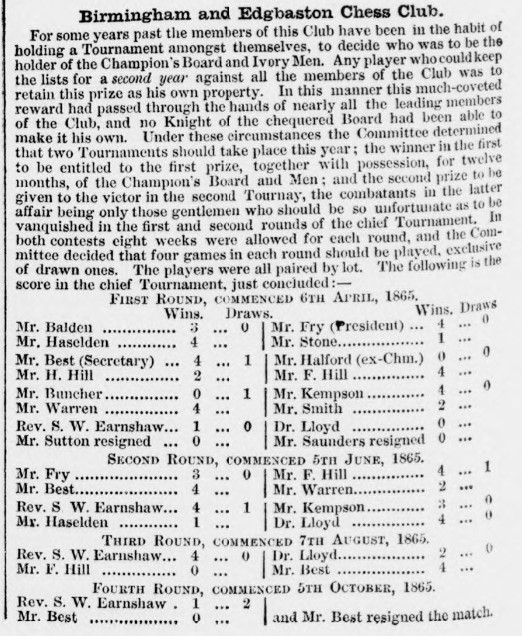
He was also submitting many of his games, losses as well as wins, to the Birmingham Journal (editor unknown, appearing irregularly between 17 June 1865 and 26 December 1868, 57 articles in total, according to Tim Harding in British Chess Literature to 1914). One wonders if Earnshaw himself wrote the column, given that it published many of his games and stopped at the point when he left Birmingham.
Let’s look at a few of them.
You can judge from these games that Earnshaw enjoyed attacking chess, being particularly fond of the Evans Gambit.
He was also travelling down to London to play at the capital’s chess haunts, where he was winning games against opponents such as the German endgame expert Josef Kling.
In this game he was successful on the white side of the King’s Gambit.
At this time, matches between clubs were starting to take place. In 1866 he played for Birmingham in a match against Worcester. Although he lost both his games, his team scored a narrow victory.
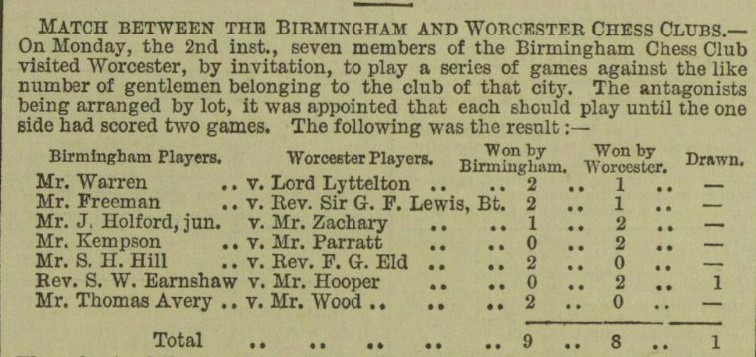
You’ll spot some interesting names in the Worcester squad. There’s Lord Lyttelton, Lord Lieutenant of Worcestershire and sometime President of the British Chess Association. Then we have the future Sir Walter Parratt, whom you might recall would, a few decades later, play in several Windsor – Twickenham matches.
At some point that year Earnshaw played, as you will have seen in the earlier article, a series of games against Steinitz. It’s uncertain whether these were played in London or in Birmingham. I showed you the games last time, but have now asked Stockfish for its opinion.
Another game between Earnshaw and Steinitz was published in 1879, without any indication of when (except ‘some time ago’) or where it was played. It might, I suppose, have been one of this series.
In the 1866-67 Birmingham Club Championship Earnshaw reached the semi-final, where he was paired against John Halford. After 8 games the scores were level, with three wins apiece and two draws, so lots were drawn, resulting in his opponent proceeding to the final.
Here’s one of his wins.
In April 1867 Earnshaw took part in another match, this time against a combined team from two other clubs.

Lord Lyttelton was again representing the opposing team. I guess he was an honorary member of several clubs. Within a couple of decades exceedingly pleasant meetings between chess clubs would become much more frequent, strengthening the social bonds of friendship between Chess players. Long may they continue.
But then there seems to have been a break in Earnshaw’s chess career. In August 1867, as reported in my previous article, he was involved in a tragic incident, which must have affected him very much. Perhaps as a result, he left Nether Whitacre at the end of the year. His last baptism was in November, and by 22 December a new incumbent had taken over.

And look! There, on the other side, is Maria Howton (Houghton)’s illegitimate son, not, I should add, her first, fathered by a butcher in a neighbouring village, being baptised. Maria was a sister of my great grandmother Jane Houghton. Soon afterwards she’d finally marry, and Henry would take on his step-father’s surname, becoming Henry Tomes.
Earnshaw then took on a chaplaincy in Tremadog in North Wales, before being appointed headmaster of Archbishop Holgate School, Hemsworth, Yorkshire.
With a new job and five young children (born between 1861 and 1870) he must have been too busy to devote much time to chess, but by the mid 1870s he had joined both Sheffield and Leeds Chess Clubs. In 1874 he lost to Blackburne in a Sheffield simul, and in 1877 he was matched against a child prodigy in a friendly game.

Young Master Jackson didn’t exactly become a second Morphy, but his story is one perhaps for another time.
Here’s the game.
At the end of 1876, it appears that Earnshaw’s friend and fellow clergyman George Alcock MacDonnell took over the chess column of the Illustrated Sporting and Dramatic News. In 1877 Earnshaw returned to the ministry, becoming Rector of Ellough, a tiny village near Beccles in Suffolk, which nevertheless boasted a splendid church. His predecessor there, Richard Aldous Arnold, who had served his few parishioners for more than 60 years, came from the same family as Thomas Arnold of Rugby School and his poet son Matthew.
He now had more time for chess, travelling to London every seventh week to play at Simpson’s and Purssell’s, crossing swords, usually unsuccessfully, with the likes of Gunsberg, Blackburne, Mason and Bird, as well as winning miniatures against fellow amateurs. He would have been able to take the Great Eastern Railway from Beccles to their new Liverpool Street terminus, which had opened in 1874. He sent many of his games to Macdonnell, who was happy to publish them in his magazine column.
He was winning at one point in both these games, but ended up losing.
In the summer of 1878 Earnshaw played what would be his only public tournament, the Counties Chess Association meeting in London, but it didn’t go well for him. He only managed one draw from eight games (one may have been a loss by default) before withdrawing with four rounds still to play.
He threw away a good position again in this game.
The tournament proved controversial in more ways than one. The second class tournament included teenage prodigy Harry Jackson, whose father provoked some anger by interfering in one of his son’s games. Yes, we’ve all known parents like that. But that was a minor incident compared with the participation of the automaton Mephisto (operated by Gunsberg, although this wasn’t known at the time) in the Handicap Tournament confined to amateurs.
A few weeks later, Earnshaw tried a Fried Liver Attack against Mason when Black’s pawn was already on a6. Stockfish, unlike MacDonnell in his annotations, is happy with this, but again White lost the thread, ending up on the wrong end of a brilliancy.
Back in Suffolk, he was doing his bit to promote chess in Beccles.
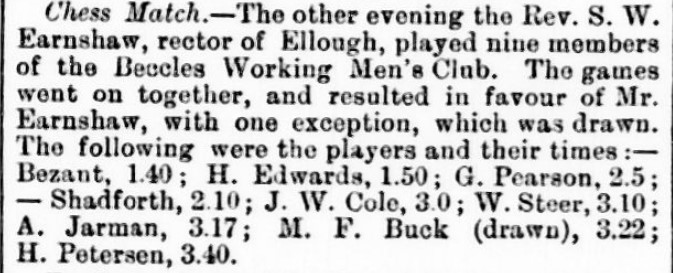
By 1880 he was even described as a ‘chess celebrity’.
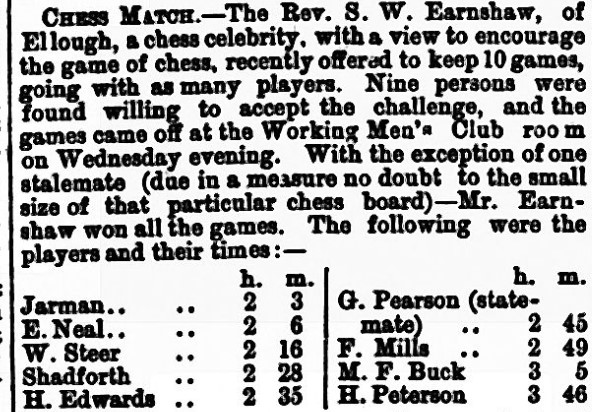
Here are a couple of wins against lower level opposition from this period.
His friend Samuel Boden’s death in January 1882 hit him hard: perhaps this is one reason why, by that time, his games were appearing less often in the press.
But in 1885 he turned up in an inter-club match. The St George’s team included Marmaduke Wyvill, runner-up in the first ever international tournament back in 1851, and formerly Rishi Sunak’s predecessor as MP for Richmond, Yorkshire.
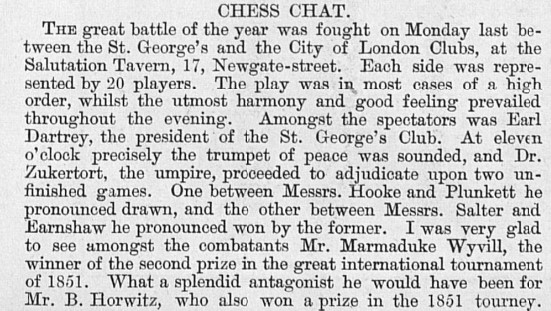
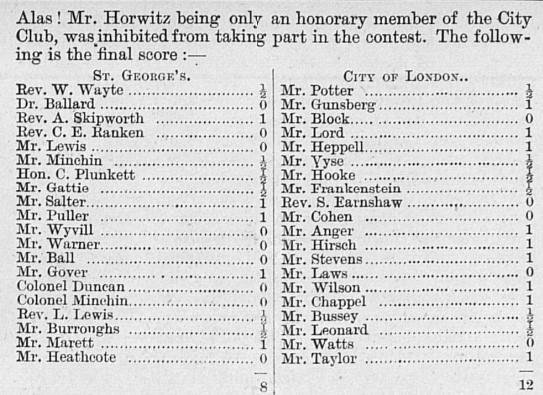
On the other side of the board, you’ll notice George Archer Hooke, who had another half century of competitive chess ahead of him, two boards above Earnshaw, with the splendidly named problemist Edward Nathan Frankenstein sitting between them.
But the next we hear from Samuel Walter Earnshaw, sadly, is from this death record, giving his name as Earnshaw-Wall (Wall was his mother’s maiden name, an affectation used by his son Walter Ethelbert Stacey Earnshaw-Wall .

The cause of death is given as Gout (21 days) and Pericarditis (3 days).
You’ll have read MacDonnell’s warm tribute to his friend in the previous article.
A true and enthusiastic lover of chess, we are told. Not a great player, but a good enough player, and really that’s all that matters. He was, for his day, well booked up, enjoying gambit play and demonstrating strong attacking skills, but all too often he would miscalculate or make careless mistakes and throw away his advantage. But he clearly enjoyed playing, whether against fellow amateurs or against the leading masters of his time. He, and many others like him, over the past 150 years or more, are what chess, in my opinion, is really all about. I’m delighted that my great grandmother and her family had made his acquaintance.
Join me again soon for more Minor Pieces.
Sources and Acknowledgements:
ancestry.co.uk
findmypast.co.uk/British Newspaper Library
Wikipedia
ChessBase 17/Stockfish 17
chessgames.com (Earnshaw here)
Yorkshire Chess History (Steve Mann: Earnshaw here)|
EdoChess (Rod Edwards: Earnshaw here)
British Chess Literature to 1914 (Tim Harding: McFarland 2018)
Steinitz in London (Tim Harding: McFarland 2020)
Other sources referenced and linked to above
